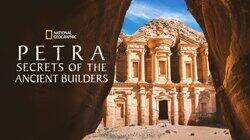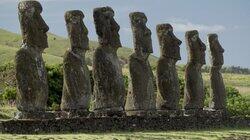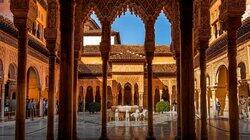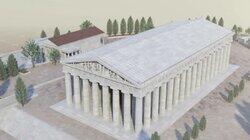Ancient Builders - Season 1

Season 1

Episodes

Petra: Secrets of the Ancient Builders
In the south of Jordan, in the heart of the desert, lies the spectacular city of Petra. Built more than 2,000 years ago, it contains innumerable architectural treasures: colossal buildings carved into cliffs, hundreds of tombs, temples, and baths... Petra, the capital of the Nabataean Kingdom, was a rich and prosperous city. And yet, it resides in the heart of a very inhospitable region. So why did the Nabataeans decide to build their capital here? And above all, how did they manage to transform this desert area into a luxurious city? The film takes you on a discovery of the technical prowess behind this oasis of stone. You will see how the workers shaped these spectacular buildings through amazing techniques. You will learn how rain was gathered to provide the city with water. And you will even discover the construction secrets of what could be the first anti-seismic buildings in human history. Through the use of computer graphics, interviews with the world's leading experts, and footage of the extraordinary remains of this city, this documentary will offer you an unprecedented immersion into the construction of this unique city.

Easter Island: Sculptors of the Pacific
Easter Island is one of the most isolated on Earth. However, its people, the Rapa Nui, have left behind an exceptional heritage: Dwellings, ceremonial altars, and above all nearly 900 moai, these giant statues measuring 3 to 5 meters on average and which are scattered all over the island. Supposedly built between the 13th and the 17th centuries, they were sculpted out of blocks of tuff, a volcanic rock extracted from the Rano Raraku volcano. They were then placed over an ahu, a type of platform made out of basalt that served as an altar.
How were the Rapa Nui able to carve out basalt, a hard, volcanic rock, with the limited tools at their disposal at the time? And how, long before the advent of the modern wheel and of metal on the island, did the locals cut, shape, and transport their stone giants weighing several tons? This film presents all the current theories expressed by experts, including the latest scientific hypotheses: What if the moai weren't transported in their "finished" state, as has been the common belief for centuries? And what if the quarry from which they stem wasn't abandoned, instead of being voluntarily transformed into the grandiose monument it is today? Many other remains attest to the locals' impressive mastery: The techniques to cultivate their fields by collecting water using rocks, their most prestigious dwellings, or even a hydraulic site that was only recently discovered, and the meaning of which remains unknown…

The Alhambra: Fortress of Andalusia
In the South of Spain stands one of the most sumptuous palaces ever built: the Alhambra. An impressive fortified complex erected at the top of a steep hill, it was mainly built by the Nasrids, a 13th-century Arab dynasty. Behind the apparent austerity of this immense fortress - no less than 2,000 metres of defensive walls and 27 towers - the inside unveils an explosion of refinement and ornamentations, gardens and marble fountains, a grandiose testament to the tradition of Moorish style and Islamic art of the period. From the building techniques used to the delicacy of the decorative fixtures, discover how artisans of the period managed to create sculpted fixtures of such beauty and how the labourers worked, throughout the centuries, to make this citadel as practical as it is refined.

Jerusalem: Builders of the Holy City
For over three thousand years, Jerusalem has been the stage of the foundation of many a myth. These founding tales have forged the great civilizations of the past, starting with the Judaic civilization.
From Antiquity on, the most prestigious architects of the Mediterranean Basin applied themselves to turning this isolated city into one of the jewels of the Middle East.
At the heart of the city, the Romans raised an entire mountain with a view to building the Temple Mount, an immense religious complex drawing from the heritage of the famed Temple of David so sacred in Jewish religion. In order to transport the enormous blocks of stone that make up this architectural feat - the heaviest weighing 400 tons - they had to resort to incredible levels of ingenuity. Centuries later, one of the first great Christian churches would be erected in the center of the city: The Church of the Holy Sepulchre. This monumental edifice was built by Emperor Constantine around the tomb of Christ. A central focus of Christianity for nearly three centuries, Jerusalem never ceased to reinvent itself with each conquest. Years later, it would give rise to one of the wonders of Muslim architecture: The Dome of the Rock, the Islamic Empire's response to the Constantinian Church of the Holy Sepulchre.
From the Temple's esplanade to the Dome of the Rock, how were these structures built back in the day? What techniques have allowed them to cross the ages and withstand every earthquake, war, and conquest?
From one hill to the other and from civilization to civilization, this documentary takes an inside look inside the heart of Jerusalem's iconic monuments that have witnessed 3,000 years of history and mystery, as we reveal the secrets of the Eternal City and its holy builders.

The Acropolis: Secrets of the Ancient Citadel
In the heart of Athens, the vestiges of an ancient city have overlooked the capital for over 2,000 years: the Acropolis. Built in the 5th century BC, this sumptuous complex of temples and monuments remains the most extraordinary architectural work left to us by Ancient Greece.
Thanks to CGI and explanations of the foremost international experts, discover the technical feats of Antiquity that allowed a rocky hill to be transformed into a monumental and immortal masterpiece. From the infallible anti-seismic systems to the techniques used to hoist blocks of marble weighing several hundred tons to the top of the hill, walk in the footsteps of the greatest engineers of Ancient Greece and discover their ingenuity, precision, and perfectionism.
Recently Updated Shows

Contraband: Seized at the Border
The border between the USA and Mexico is the busiest in the world. This series follows the work of America's Customs and Border Protection agency, whose job is to defend the border and stop terrorists, drugs and illegal weapons from entering the country.

History's Greatest Mysteries
History's Greatest Mysteries will investigate a wide range of historically compelling topics and the mysteries surrounding each including the Titanic, D.B. Cooper, Roswell, John Wilkes Booth, and more. Each program within the franchise will showcase fresh, new evidence and perspectives including never-before-released documents to the general public, personal diaries and DNA evidence to unearth brand-new information about these infamous and enigmatic chapters in history.

Saturday Night Live
Saturday Night Live is an Emmy Award-winning late-night comedy showcase.
Since its inception in 1975, "SNL" has launched the careers of many of the brightest comedy performers of their generation. As The New York Times noted on the occasion of the show's Emmy-winning 25th Anniversary special in 1999, "in defiance of both time and show business convention, 'SNL' is still the most pervasive influence on the art of comedy in contemporary culture." At the close of the century, "Saturday Night Live" placed seventh on Entertainment Weekly's list of the Top 100 Entertainers of the past fifty years.

American Horror Story
American Horror Story is an horror television anthology series. Each season is conceived as a self-contained miniseries, following a disparate set of characters and settings, and a storyline with its own beginning, middle, and end. While some actors appear for more than one year, they play completely different roles in each season.
